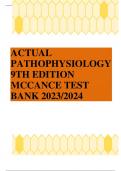Page 4 out of 40 results
Sort by
Test Bank For Pathophysiology Chapters 9, 14, 15 Study Guide (A+ GRADED 100% VERIFIED)
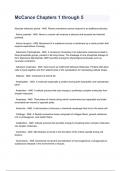
-
McCance Chapters 1 through 5 Questions, answers and rationale of correct answer.
- Exam (elaborations) • 14 pages • 2023
-
- $12.49
- + learn more
McCance Chapters 1 through 5 Absolute refractory period - ANS Plasma membrane cannot respond to an additional stimulus. Action potential - ANS Nerve or muscle cell receives a stimulus that exceeds the theshold potential. Active transport - ANS Movement of a substance across a membrane by a carrier protein that requires expenditure of energy Adenosine Triphosphate - ANS A compound consisting of an adenosine molecule bonded to three phosphate groups, present in all living tissu...
QUESTIONS AND ANSWERS
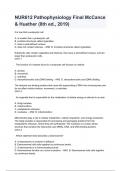
-
NUR612 Pathophysiology Final McCance & Huether (8th ed., 2019)
- Exam (elaborations) • 180 pages • 2024
-
- $10.99
- + learn more
NUR612 Pathophysiology Final McCance & Huether (8th ed., 2019) It is true that a eukaryotic cell A. is smaller than a prokaryotic cell. B. contains structures called organelles. C. lacks a well-defined nucleus. D. does not contain histones. - ANS B. Contains structures called organelles. Eukaryotic cells contain organelles and histones, they have a well-defined nucleus, and are larger than prokaryotic cells. Ch01.1 The function of a histone found in a eukaryote cell focuses on...
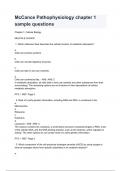
-
McCance Pathophysiology chapter 1 sample questions with Verified Solutions
- Exam (elaborations) • 16 pages • 2024
-
- $8.99
- + learn more
McCance Pathophysiology chapter 1 sample questions Chapter 1: Cellular Biology MULTIPLE CHOICE 1. Which statement best describes the cellular function of metabolic absorption? a. Cells can produce proteins. b. Cells can secrete digestive enzymes. c. Cells can take in and use nutrients. d. Cells can synthesize fats. - ANS ANS: C In metabolic absorption, all cells take in and use nutrients and other substances from their surroundings. The remaining options are not inclusi...
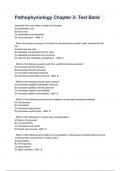
-
Pathophysiology Chapter 2- Test Bank with Verified Solutions
- Exam (elaborations) • 12 pages • 2024
-
- $7.99
- + learn more
Pathophysiology Chapter 2- Test Bank Insensible fluid loss refers to water lost through: A) perspiration only. B) feces only. C) perspiration and expiration. D) urine and feces. - ANS C When the osmotic pressure of the blood is elevated above normal, water would shift from the: A) blood into the cells. B) interstitial compartment into the cells. C) interstitial compartment into the blood. D) cells into the interstitial compartment. - ANS C Which of the following would result...
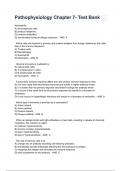
-
Pathophysiology Chapter 7- Test Bank with Answers and Rationales
- Exam (elaborations) • 5 pages • 2024
-
- $3.99
- + learn more
Pathophysiology Chapter 7- Test Bank Neutrophils: A) are phagocytic cells. B) produce histamine. C) produce antibodies. D) are elevated during an allergic response. - ANS A Which cells are required to process and present antigens from foreign material as the initial step in the immune response? A) T-helper cells B) Macrophages C) Eosinophils D) Monocytes - ANS B Humoral immunity is mediated by: A) natural killer cells. B) T lymphocytes (T cells). C) B lymphocytes (B cel...
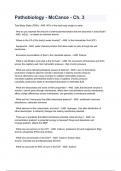
-
Pathobiology - McCance - Ch. 3 Rated 100%
- Exam (elaborations) • 4 pages • 2024
-
- $5.49
- + learn more
Pathobiology - McCance - Ch. 3 Total Body Water (TBW) - ANS 60% of the total body weight is water . How do you express the amount of chemicals/electrolytes that are dissolved in body fluids? - ANS mEq/L - is related to chemical activity Where is the 2/3 of the body's water located? - ANS In the intracellular fluid (ICF) Aquaporins - ANS water channel proteins that allow water to pass through the cell membrane. Excessive accumulation of fluid in the interstitial spaces. ...
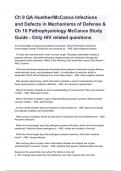
-
Ch 9 QA Huether/McCance Infections and Defects in Mechanisms of Defense & Ch 10 Pathophysiology McCance Study Guide - Only HIV related questions
- Exam (elaborations) • 2 pages • 2024
-
- $3.99
- + learn more
Ch 9 QA Huether/McCance Infections and Defects in Mechanisms of Defense & Ch 10 Pathophysiology McCance Study Guide - Only HIV related questions An immunologist is discussing endotoxin production. Which information should the immunologist include? Endotoxins are produced by: - ANS gram-negative bacteria. A 5-year-old male becomes ill with a severe cough. Histologic examination reveals a bacterial infection, and further laboratory testing reveals cell membrane damage and decreased protein ...

That summary you just bought made someone very happy. Also get paid weekly? Sell your study resources on Stuvia! Discover all about earning on Stuvia


